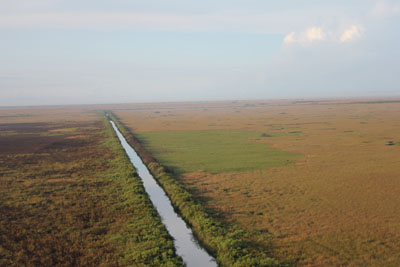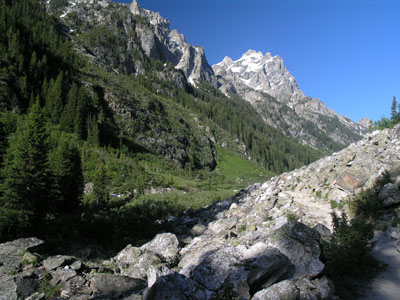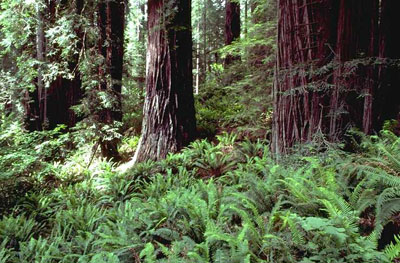
Parks seek to expand to protect environs
Looking at the Everglades on a map, one could see the system begin with the Kissimmee River and extend itself all the way down to Florida Bay.
Yet, only one-seventh of this area is known as the Everglades National Park in South Florida.
| Click on a video at the left to view an audio slideshow about expansion and growth of existing national parks narrated and prepared by writer Ingrid Castillo. |
One of the biggest challenges faced by national parks is the process of land acquisition. Some parks, like the Everglades, seek to acquire land in their surrounding area in order to incorporate it as part of the national park and to preserve and protect regional environments.
When the Redwood National Park in Northern California was established in 1968, Congress failed to take into consideration the impact the surrounding area outside the park would have on the land. Things like construction and logging were having detrimental effects on the redwood forest.
Eventually, the evidence of outside activities and their damaging impact on the park led Congress to expand the park from 56,000 acres to 106,000 acres in 1978.
Though this may seem like a smooth transition, the transition was anything but smooth and a lot went into making that expansion happen.
| The area of the Everglades in South Florida known as Frog City (Photos courtesy of National Park Service). |  |
One of the main obstacles with expanding national parks is the issue of money. Funding for land acquisition often comes from private grants, organizations and the Congress.
The NPS’s annual budget, which must be approved each year by Congress, contains a federal land acquisition priority list in which it shows which national parks are set to receive money for land acquisition, how much land they are set to acquire and the amount it would cost to acquire these lands.
When then President Jimmy Carter signed the bill expanding the Redwood National Park in 1978, it provided $359 million for expansion. However, expansion was not the only thing the money accounted for.
Another difficulty faced by national parks is how to acquire land that is privately owned. In the case of Redwood National Park, one of the major opponents to the 1978 expansion was lumber companies.
The lumber companies argued the trees they were cutting did not in any way affect the redwood forest and that, if the park were to be expanded, the lumber companies as well as the community, stood to lose at least 2,000 jobs.
 |
Cascade Canyon and trail with Cathedral Group of Grand Teton National Park in Montana. |
Congress eventually felt that the damage done by logging was far too great and decided to expand the park. In exchange, to make up for the job loses, the $359 million had provisions for job creation in park rehabilitation projects.
Though government does play a major role in funding for land acquisition, often times the land is donated by an estate or a private organization.
In 1990, The Richard King Mellon Foundation bought more than 100,000 acres of land in several states and donated to the United States so that national parks could be expanded. At the time the $21 million worth of land was considered one of the biggest private donations.
Most recently, in 2001, the Rockefeller family donated its 1,106 acre ranch in Wyoming to become part of Grand Teton National Park. This came at a time when the Bush administration provided no new park acquisitions for its 2001 budget.
Even if the challenge of acquiring funds is overcome, national parks still face the challenge of opposition from businesses and private citizens.
In the land expansion of 1978, lumber industry employees voiced their opposition by protesting outside of capitol building in Sacramento while the decision to expand the park was being made. They felt the need to protect their assets something that can be seen in a number of cases.
Many businesses see the land not as a conservation site, but as a business opportunity. For example, the lands yet to be acquired by the Everglades National Park are farmlands. The business communities surrounding parks see the expansion often times as having a negative effect economically.
Private citizens that own homes in the vicinity of national parks also feel threaten by a possible park expansion.
For private landowners, there’s a constant struggle between environmentalist, government officials, the public and themselves at which they find themselves as the losing party.
| A redwood forest with ferns in Redwood National Park in California. |  |
For the residents near the Indiana Dunes National Lakeshore Park, mostly farmers, felt that their rights were being violated by a possible expansion. Though the expansion would leave them their farmhouses, it would immensely reduce their farm sizes. Landowners often feel that their needs are not being heard despite their active participation in the expansion process.
There have been organizations formed in order to find a common ground between landowners and conservationist. Groups like the Texas’s Cameron County Agricultural Coexistence Committee consists of farmers, government officials and environmentalists that work on ways to address issues in a way that ensures every sector involved in conservation is heard.
In the end, national parks despite their struggles for expansion, seem to find a way whether through donations or federal funding to achieve their goals. Not always can a park expand in the time and pace it wishes but so long a park can conserve the area it has, land acquisition can sometimes take a backseat.

Comments are Closed